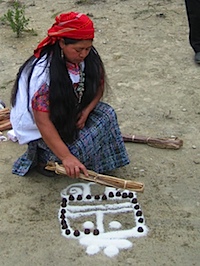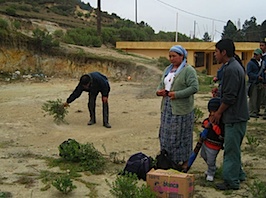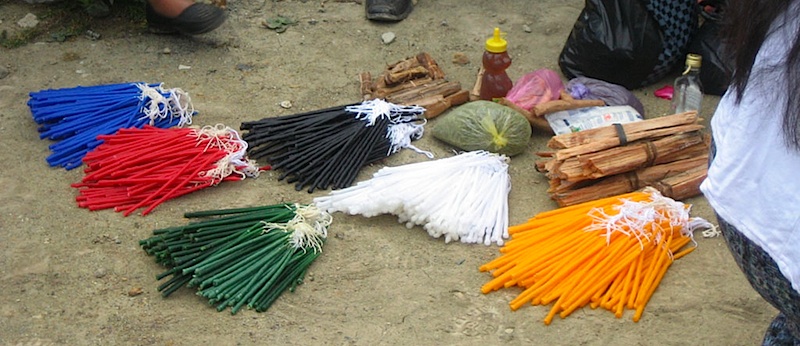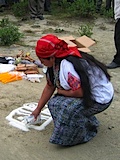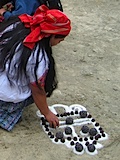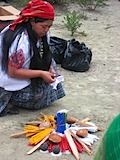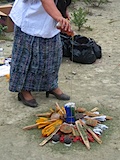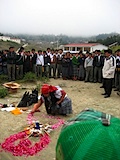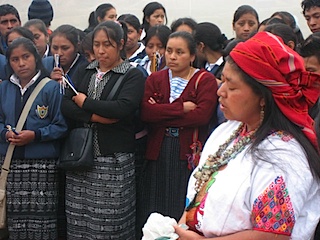I rarely get to talk about costumbre maya (the Mayan religion), because it’s sortof underground, both literally and figuratively. Besides the fact that the really important ceremonies happen in caves hidden deep within the mountains, the Mayan religion exists as a shadowy partner to the pervasive and deeply entrenched Catholic presence. Since the Spanish conquest 500 years ago, the Mayan have practiced a hybrid form of Catholicism. Much like gays in the military, it’s “don’t ask, don’t tell”: you can sacrifice animals in the caves and worship the four winds in your home, as long as you still show up for mass on Sunday. This hybridization is made easier by several favorable coincidences, such as the cross: besides being a convenient place to nail up earthbound deities, if you make all the legs the same length, it is a prehistoric Mayan symbol for the four cardinal directions of the earth and the four winds that rule the skies.
Being a gringo and outsider, though, I don’t get exposed to much costumbre maya: the occasional announcement at the end of a town meeting (“the priests were in the caves and saw blood running from the walls, everyone pass in 5q so they can buy stuff to sacrifice”) or the presence of brightly colored ceremonial candles in a few local shops are the only clues that there is a powerful and ancient earth god present in these mountains.
The start of the Mayan teachers’ school project, however, gave me a chance to see some of the local religion firsthand. Since the school is an important undertaking and it’s specifically Maya, the local sacerdote maya (mayan priestess) was invited to bless the grounds before we start construction, and as the local gringo celebrities, the four local Peace Corps volunteers were invited to attend.
I arrived early in proper gringo style, and was soon joined by Mario, Raymundo, Pascual, and a few other men from the building committee. A woman I didn’t recognize was with them. As I talked with Pascual, Mario grabbed a piece of escoba plant from the hillside and started sweeping a flat place in the ground. The woman opened a bag and put on a fantastically embroidered shirt, and that is when I realized she must be the Mayan priestess. This caught me off guard, because I was expecting a male priest. Not only is this a very sexist society, but the construction of the Spanish phrase “sacerdote maya” implies a male. I need to ask Nas Palas about it, but maybe all Mayan priests are female? The one we saw during training was a lady as well.
As the priestess was unpacking a box of ceremonial supplies, the students from the school started to gather. The director (Mario) let them all out of their classes to participate, and we were soon surrounded by a milling mob of 200 blue uniforms. The students all had armloads of flowers. “Separate the flowers by colors, pull off the petals, and but them in these bags,” he instructed. I noticed four shy looking girls standing to the side, shifting nervously.
“Mira, estan timidas” I said to him as I nodded my head towards the girls, assuming they were afflicted with the shyness common when teenage Mayan girls are near white men.
He chuckled. “No, son evangelicas.” Oh dear. They were members of the third religion here, the Evangelical Christians.
Evangelism arrived in Guatemala in the 70s, as central America became more open to tourism and travel. Evangelistic churches in the US soon realized that the Guatemalan people were receptive to their message, and the cost of doing business in Guatemala was extremely low. They sent massive waves of missionaries, built a lot of churches, and donated a lot of social aid. Their prohibitions against drinking and dancing were a welcome respite to women everywhere who were tired of getting beaten by their drunk husbands. Men, in turn, started turning to the Evangelical churches because that was where the women were. Today, about thirty percent of Guatemalans identify themselves as Evangelist, and proclaim it proudly over loudspeakers for all to hear. I have to suffer through their abominable music several nights a week.
Besides eschewing alcohol and dancing, though, the Evangelists also see costumbre maya as Satan worshipping. The four “shy girls” feared for their immortal souls.
As the students worked on their flower petals, the priestess was preparing for the ritual. She cut the string off of the cardboard box Raymundo brought, containing the 300q-worth of supplies they had bought her to perform the ceremony. Many of the items were familiar to me:
- candles: white for the north, red for the east, yellow for the south, black for the west (1), green for the earth, and blue for the sky. The colors also have additional significance for love, death, birth, etc. but I can’t remember what they all are.
- ocote, a pine resin that smells great and is a natural firestarter
- incense balls made from who-knows-what. Smells GREAT, though.
- honey, because the gods like the taste of it.
- panela (unrefined brown sugar). For the same reason as honey.
- chocolate, an ancient thing of Mayan invent
- white sugar. It is used to draw glyphs and symbols.
- cusha (homemade liquor). The gods like that too.
- pine needles. They symbolize the earth, and are quite fragrant.
- xeka, a type of sweet bread.
Once her things were unpacked, she began by using the sugar to draw a glyph on the ground. “What’s that glyph mean?” I asked, half to myself. Katal, the PCV from the other village, was apparently paying more attention than I was. “It’s aq’ab’al, today’s glyph in the Mayan calendar.” Aq’ab’al signifies beginning great endeavors and fresh starts (2). She went on to tell me that they were going to do the ceremony yesterday, but the priestess said that yesterday was Iq’ and is NOT an auspicious day to start things like building projects.
After the glyph was drawn, the priestess continued to arrange her ceremonial offering, placing everything in a way that seemed pretty consistent with what I’d seen before: incense upon sugar, panella on top, candles added in radial pattern according to the 4 compass points, with the earthbound stuff (pine, ocote, etc.) on top of that. She then took flower petals, and drew circles off of the ceremonial pyre, corresponding in color with the four compass points. As she worked, a few students circulated throughout the crowd, passing out candles and more flower petals.
When all was in place, there was a brief pause, then the priestess began to speak. She began by explaining that the costumbre mayais a part of their culture, whether your believe in it or not, and that it needs to be respected. “Some say that the fire we light is the fire of Hell,” she continued, without making any sort of gesture towards the Evangelical contingent hiding in the back of the group. “But that is not so. It is not sinful to respect your past, to respect your history, to respect your culture. The fire, it keeps us warm and cooks our food. Without it, we cannot survive. The Earth, it gives us food and a place to live. Without it, we cannot survive.”
As she talked, I thought about how the Q’anjob’al are fighting this constant struggle to maintain their culture. But it’s not a fight against conquistadores, or oppressive government troops, or even zealous missionaries. It’s become a fight against television, fancy imports, and their very own children. Being Maya isn’t “cool”, the clothes aren’t trendy, the beliefs seem quaint compared to the technology they encounter in school. Moms want their kids to speak only Spanish. The few men that wear traje are the over-60 crowd. Last week, Nas Palas’s son came over to our house to borrow my capishay because he was going to be the caballero in the town parade, the equivalent of the Prom King. It’s sad that a young, successful Mayan guy has to borrow traditional garb from the only gringo in town.
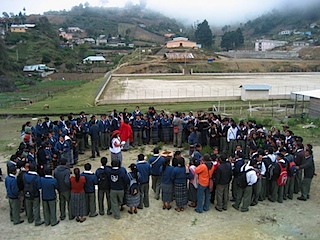 After the introductory speech, the ceremony began. It was intended to give thanks for the coming school, and to ask for aid from the earth and spirits during the construction to prevent accident or mishap. The priestess spoke mostly in Spanish, probably in deference to the gringoes present. With her prompting, we turned to face the four cardinal directions, and blow flowers to the winds. Thanks were given to the spirits, and the 20 Mayan days were counted. As she went through each day, students who were born on that day came up and put their candles into the ceremonial fire.
After the introductory speech, the ceremony began. It was intended to give thanks for the coming school, and to ask for aid from the earth and spirits during the construction to prevent accident or mishap. The priestess spoke mostly in Spanish, probably in deference to the gringoes present. With her prompting, we turned to face the four cardinal directions, and blow flowers to the winds. Thanks were given to the spirits, and the 20 Mayan days were counted. As she went through each day, students who were born on that day came up and put their candles into the ceremonial fire.
At one point, there was a sudden rush of students, pushing and giggling. “What was that all about?” I asked as they added their candles.
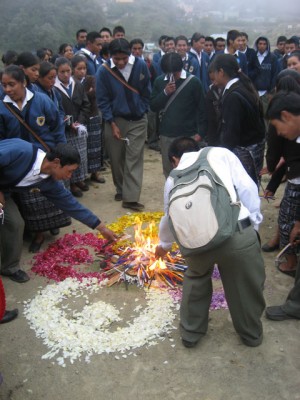 “That was the day the priestess said anyone can add candles, if you don’t know your own day,” Katal whispered. Wow. About a quarter of the students didn’t know their tzolkin. That’d be like me not knowing I am a Taurus.
“That was the day the priestess said anyone can add candles, if you don’t know your own day,” Katal whispered. Wow. About a quarter of the students didn’t know their tzolkin. That’d be like me not knowing I am a Taurus.
When we came to the day tz’ikin, Katal went up and added her candles, as did Pascual, the cool old mason who is supervising construction. They smiled at each other, discovering a subtle kinship of their birthday. “What is your tzolkin?” Katal asked me. I felt kindof silly; she looked it up for me a few months ago, but I’d already forgotten it (3).
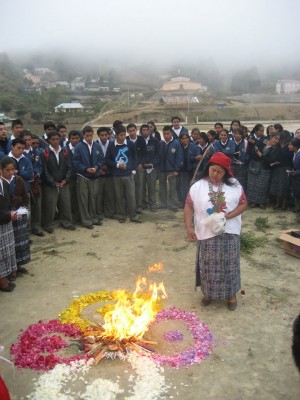 About that time, the wind started to pick up and the clouds were settling it, bringing with them a cold mist. Despite my capishay, I was shivering. Everyone pressed closer to the ceremonial fire, and the sweet stink of burning pine resin, chocolate, incense, and flower petals drifted over us.
About that time, the wind started to pick up and the clouds were settling it, bringing with them a cold mist. Despite my capishay, I was shivering. Everyone pressed closer to the ceremonial fire, and the sweet stink of burning pine resin, chocolate, incense, and flower petals drifted over us.
“There are some of you here who don’t respect your parents,” the priestess continued. “You stay out late, don’t do you schoolwork, and cause pain in the family.” I guess some things are the same, no matter what the religion. “This is the fire speaking, not me,” she continued. She admonished the students to live rightly, using her position as a spiritual leader to try to make the community a better place. I am not convinced the chastising approach works, but I am not a religious person. Perhaps when a priest or pastor or shaman says these things to their congregation, it speaks to something deep within a person that I don’t have.
Soon after,the ceremony drew to a close. Bit by bit, the students dispersed. “We get the rest of the day off, right?” one asked hopefully of Mario, already knowing the answer would be “no”. Pascual, Mario, Raymundo and I all gathered closer as the priestess took off her ceremonial robe. We each got a chance to thank her for coming, and she was very pleasant to talk to.
I spliced together a video of several short clips from the ceremony. It’s here, on YouTube:http://www.youtube.com/watch?v=uEL-epJnbmw
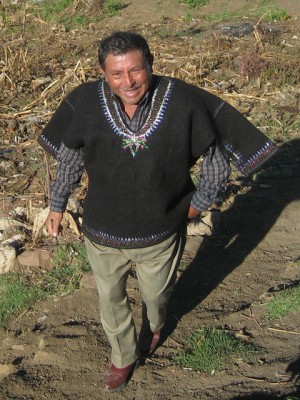 When I got home, Chalio came running up to me. “Jaime, Jaime! Nas Palas bought a capishay!” Not believing it, I leapt to my feet to go see if it was true. Nas Palas, my friend and neighbor, one of the pillars of the community, had never owned a capishay. I once asked him why, and he said “they’re too expensive,” but I never fully believed the story. I regularly find myself teasing the young men of the community about not wearing one, and they laugh and go about their business… but the old guys? It’s not my place to tell them what to do. But when I rounded the corner, there he was, coming through the field with a huge smile on his face. Wearing a pretty new capishay.
When I got home, Chalio came running up to me. “Jaime, Jaime! Nas Palas bought a capishay!” Not believing it, I leapt to my feet to go see if it was true. Nas Palas, my friend and neighbor, one of the pillars of the community, had never owned a capishay. I once asked him why, and he said “they’re too expensive,” but I never fully believed the story. I regularly find myself teasing the young men of the community about not wearing one, and they laugh and go about their business… but the old guys? It’s not my place to tell them what to do. But when I rounded the corner, there he was, coming through the field with a huge smile on his face. Wearing a pretty new capishay.
Perhaps the Q’anjob’al still have a chance.
1) The colors in the school are matched to the Mayan universe, as well. For example, the east wing has red accent colors.
2) Aq’ab’al is also the name of a restaurant in town. I asked both Aurelio and Pedro what aq’ab’al means in Q’anjob’al, and neither of them knew. I guess they aren’t superstitious people.
3) I have since found it to be Tijax, the spirit of doctors and healers. I will try not to forget it, in case I get to attend another ceremony. You can check your own here.
